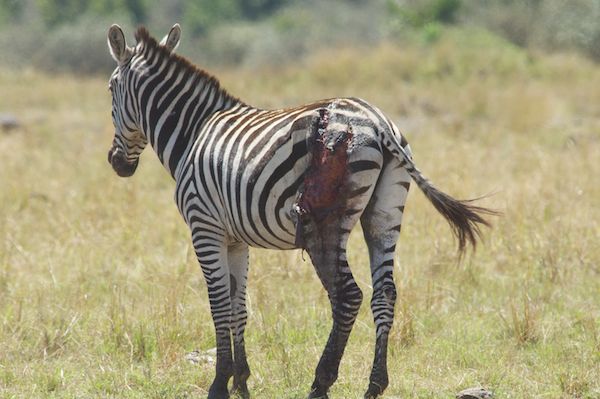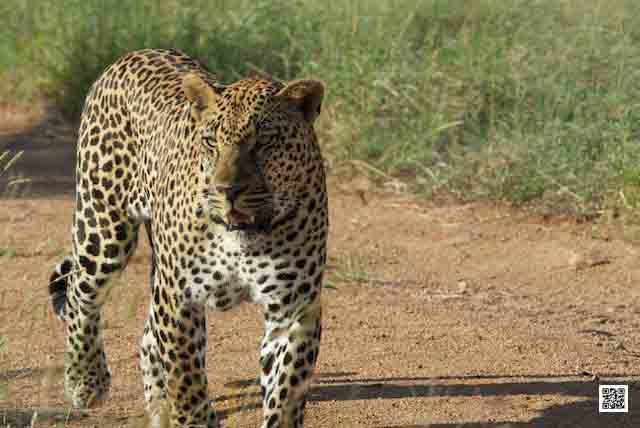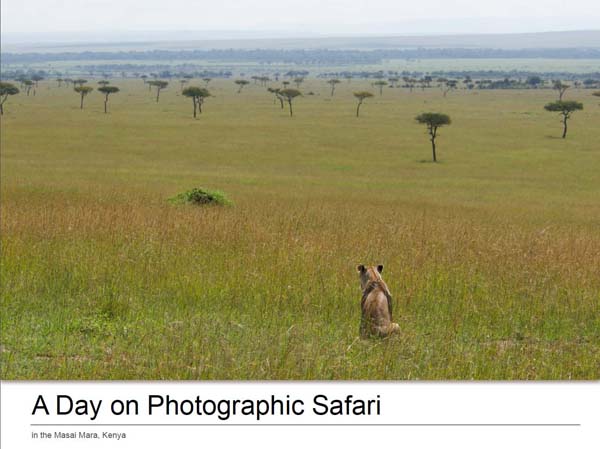12 May 2013
ePhoto Book: Black & White
18/05/13 08:48 Filed in: Photography & Art

Wildlife Photography from the early photographic safaris where in black and white and they still breath the mystery of the times back then. But maybe its what black and white photography does anyway, it looks mystic, secretive and gentle.
View the ephoto book here.
Ute Sonnenberg for www.rohoyachui.com
On Photo Safari: Whwn You See Busses
18/05/13 08:47 Filed in: Photographic Safari

When you plan to go on a photographic safari, wildlife photography course or team building photographic safari you will most likely picture yourself on a 4x4 safari vehicle, looking out over the bush, animals passing by and silence. No sigh of civilization is in your picture, no noise on disturbance.
When you eventually get to your photographic safari destination and you are driving on a tar road and a touring bus is coming towards you, you know that there is something wrong. Your are not at the right place, this is not the safari feeling you came for.
I other words, be careful where you are going, inquire carefully about the national parks you are visiting and what you can expect to see. Only the private game reserves can provide the undisturbed safari experience, but also parks like the Masai Mara are great. Often national parks close to big cities are used for excursions for schools or big groups of tourists. Keep that in mind when you plan your trip.
Enjoy the wildlife and have fun with your photography.
Ute Sonnenberg for www.rohoyachui.com
How to Learn form Sally Mann
17/05/13 12:54 Filed in: Wildlife Photography Courses

Being on photographic safaris, wildlife photography courses or team building photographic safaris means being out in the bush, in nature. That means that one sees not only the cute lion cub, but also a carcass of an animal or even a lion or leopard kill. Some will think immediately “I don’t want to see a kill or carcass” and others are keen to see the rare sighting of a kill. No matter how you feel about in advance, when suddenly witnessing it is a very special experience, not only as a person, but also as a photographer.
Photographing a kill or a carcass asks for dignity, yet showing the whole truth of the moment. Sally Mann is an American photographer who does that in an artistic and careful way as her images show. It is like the photographer becomes responsible to capture the essence of the moment and to tell its story. The animal is not gone, it lives on in the images and it will not be forgotten.
See more of Sally Mann’s work on her website.
Ute Sonnenberg for www.rohoyachui.com
How to Learn from Sid Kaplan
16/05/13 13:06 Filed in: Wildlife Photography Courses

Photographing in the Masai Mara in Kenya can be challenging with regards to the intense bright light between the golden hours in the morning and the late afternoon. Feedback from people on photographic safaris, during wildlife photography courses and team building photographic safaris often goes about frustration with washed out looking images. The colors are washed out and it looks over exposed. There are a few ways to get better results, but it is also possible to play with the natural tendency to over exposed images in this environment.
Sid Kaplan, the legendary master printer and photographer uses over exposure (and under exposure) pretty often in his images and creates great effects. He dares to play with it and to let it be dominant in the image. Yet there is always contrast and that might be the secret.
The bright day light in the Masai Mara tends to let everything look over exposed, but there is always some shade or a dark tree trunk that provide contrast. No play with the focus point and/or metering and create Sid Kaplan inspired photographs of wildlife and fabulous landscapes.
Inspired? Happy snapping!
Ute Sonnenberg for www.rohoyachui.com
Learn Perspectives from Cédric Gerbehaye
15/05/13 09:07 Filed in: Wildlife Photography Courses

An amazing thing to play with during photographic safaris in the Masai Mara, wildlife photography courses and team building photographic safaris is landscape photography by using wide-angle lenses. Ideally are clouds on a blue sky and a dirt road leading to the horizon. They are the helpers in creating perspective, giving the image depth. Yet also here, training the eye is possibly the most important thing. Photographer Cédric Gerbehaye can be a great example to learn from and to train the eye by looking at his images. He is a master in black and white photography and even portraits of people show depth and perspective.
Inspired? Start looking for perspectives in your own garden, in the park or in the street and create mesmerizing images.
Become yourself an example for others to learn from.
Happy snapping!
Ute Sonnenberg for www.rohoyachui.com
Train Your Eye
14/05/13 11:20 Filed in: Photography & Art

There is everyday somewhere news about a new piece of photographic equipment, promising better images and great photography. But in order to create great images one needs to see first and there is no equipment to replace the photographer’s eye.
It is not enough to physically see, it is necessary to see light and composition. The cameras try to help with the grid on the screen to create compositions according to the rule of thirds, but there is a better to learn that.
Just look at the old master and train your eye in seeing light and composition. During wildlife photography courses on photographic safaris and also during team building photographic safaris, training the eye is part of the photography basics. With examples of paintings the attendees learn to see perspectives and compositions, how the old masters used the light in their paintings and why we love them.
The best way to train the eye is to look at the old masters regularly, that the eye starts seeing paintings everywhere and no thinking is necessary anymore when creating a photograph.
Try it with art books or with galleries like the Louvre on the Internet and experience what it does to your photography.
Happy snapping!
Ute Sonnenberg for www.rohoyachui.com
Surprises on Team Buildings with Photography
13/05/13 10:48 Filed in: Team Building

When teams do a team building photographic safari with wildlife photography course they often don’t have time to prepare in any way for it. Some buy quickly a new camera and come with the equipment stilled boxed and often the first conversations around the lunch table are still the same as in the office.
It starts during the first photography sessions that the delegates get drawn into their camera and questions evolve about settings and buttons on it. They discover the ability of their equipment and are surprised what it can do for them. The next surprises are on their way during the first photographic safari game drive when they are guided to use their cameras to capture what they see and to learn about the specifics of wildlife photography. Often the evening of the first day shows images of trying and experimenting and delegates are determined to learn more the next day. The next morning the delegates are already confident in using their camera, curious to explore more and snapping away with joy and fun. And the next big surprise is happening when they eventually see the images of the morning on the laptop and everybody is enthusiast about what the colleagues photographed, ending up making a calendar of each delegate’s favorite image to remember the experience every day in the office.
Happy snapping!
Ute Sonnenberg for www.rohoyachui.com
ePhoto Book: A Day on Photographic Safari in the Masai Mara
12/05/13 10:59 Filed in: Photographic Safari

Join a reflection on a day on a photographic safari in the Masai Mara in Kenya from the early morning with the warm colors of the sunrise to the lunch picnic in the bush and the dinner in the camp.
It is just an ordinary day, yet a wonderful day.
Enjoy! View and download the ephoto book here.
Ute Sonnenberg for www.rohoyachui.com